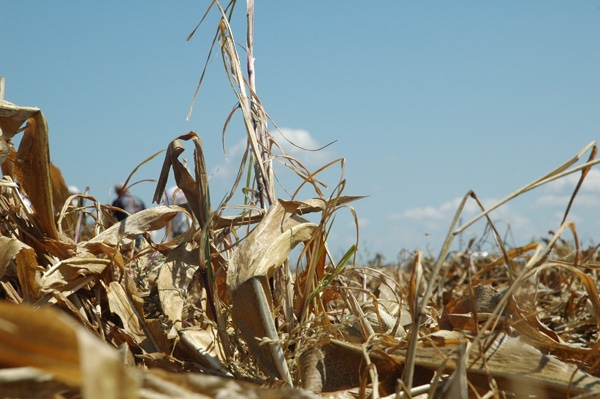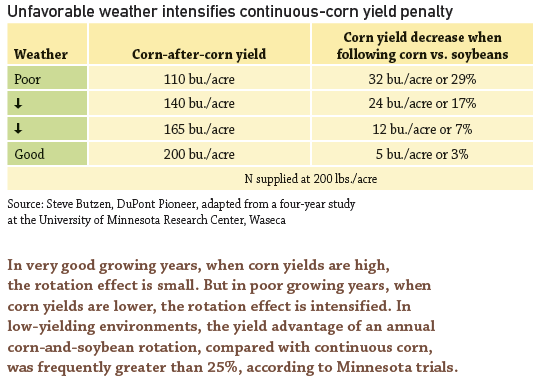
Think DifferentThe average continuous corn yield penalty increases with more years of corn production, rising 268% from year 3 to year 7, according to Illinois research.“During a good year, there is very little continuous corn yield penalty,” says Joe Lauer, University of Wisconsin corn agronomist. “But in a bad year, the continuous corn yield penalty is especially bad.”In an intensively managed continuous corn system, removing half of corn stover boosted yields by 19 bushels per acre, compared to no stover removal, says University of Illinois soil scientist Laura Gentry, research leader. However, that wasn’t enough to recoup the continuous corn yield penalty, which ranged from 25 to 49 bushels per acre.
November 20, 2013

The continuous corn yield penalty has yet to be solved. Decades of field trials throughout the Corn Belt show average continuous corn yield losses of 10-20%, says Joe Lauer. But losses can be much greater in bad-weather years.
Crop rotation is the only certain way to eliminate the continuous corn yield penalty, says Joe Lauer, University of Wisconsin corn agronomist. But tillage and good residue management can reduce it. “There’s an idea that you can overcome the continuous corn yield penalty” with intensive management, he adds, but we don’t find any research evidence for it.”
The 2012 growing season marked the third consecutive year of unusually high continuous-corn yield penalties in the Midwest, says Laura Gentry, University of Illinois soil scientist. Continuous corn yields in many places “were 30-50 bushels per acre less than corn following soybean.”
Like what you're reading? Subscribe to CSD Extra and get the latest news right to your inbox!
The causes of the continuous corn yield penalty are still a bit of a mystery. The Illinois study found that the best predictors of the yield penalty in any given year are N availability, number of years in continuous corn, and weather (see sidebar).
Fred Curtin agrees. He raises corn and cattle near Stonington, Ill., with his brother and son. Since 2000, the Curtins’ operation has been 95% corn. When the weather cooperates, they see little yield drag from continuous corn, harvesting 200-240-bushel corn crops. In recent years, though, he estimates that continuous corn yields have lagged rotated corn by about 25 bushels per acre due to less-favorable weather.
Residue prep is key
“Seedbed preparation is the most important thing for continuous corn,” Curtin says. They begin in the fall by sizing stover with a chopping corn head. After harvest, they deep-chisel plow to bury residue. That’s followed by one pass with a Case IH vertical-tillage tool to level and firm the seedbed. The next spring, they go over the field again with the vertical-tillage tool to incorporate herbicide and N. The Curtins also bale cornstalks from some fields.
In a corn-corn-soybean rotation, “farmers can get away with some types of reduced tillage, especially strip-tillage,” Gentry says. However, many continuous corn growers find they need full-width tillage after the second year to incorporate residue and speed decomposition, she says. That’s confirmed by University of Wisconsin research from 1983 to 2012, which concluded that conventional tillage boosted continuous corn yields 8-14% after the second year, compared to no tillage, Lauer says. “But it still does not overcome the continuous-corn yield penalty.”
Row cleaners on the planter are a key part of Keith Schrader’s residue-management system for continuous corn. Schrader, Nerstrand, Minn., has had very good results using floating row cleaners equipped with Precision Planting’s CleanSweep tool. Air cylinders mounted on the row cleaners let you adjust row cleaner down pressure, on-the-go, for changes in terrain or debris accumulation. “The main thing with corn-on-corn is to avoid seed contact with trash,” he says.
Yield penalty triples during years 3 to 7
The average continuous corn yield penalty increased nearly threefold from the third year to the seventh year of successive corn crops, according to 5 years’ research in east-central Illinois by University of Illinois’ Laura Gentry, soil scientist, and Fred Below, crop physiologist. The persistence of the yield penalty was regardless of N rates, they found.
“This is at odds with claims of many Corn Belt farmers who argue that continuous-corn yields eventually attain the same level as corn-soybean rotations,” Gentry says.
The causes are still a bit of a mystery. The best predictors of the continuous-corn yield penalty in any given year, the research found, are:
N availability. Soil-N mineralization decreases in continuous-corn systems, Gentry says. In very good growing years, when soils mineralize a lot of N, increased N supply can largely offset the yield penalty, she says. “Unfortunately, higher N rates do not eliminate the yield penalty during average or poor growing seasons.”
Number of years in continuous corn. The yearly residue accumulation in continuous-corn systems can lower soil temps and delay germination, tie up N, harbor diseases and fungi, and interfere with seed placement, stand establishment and soil microorganisms, Gentry says. “Our research shows a clear escalation in the yield penalty from the third year to the fifth year to the seventh year.”
Unfavorable weather is more detrimental to corn grown continuously than in rotation.

Two of these three factors — weather and soil N mineralization — are beyond farmers’ control. So, for those who decide to raise continuous corn, “managing corn stover has the greatest potential for reducing the continuous corn yield penalty,” Gentry says.
Stover harvest aids continuous corn management
Fred Curtin’s residue management system for continuous corn includes baling cornstalks on selected fields for cattle bedding and feed. To maintain soil quality, “We don’t remove more than 50% of residue,” says the Stonington, Ill., farmer, “and we don’t harvest residue from the same fields every year.”
Research at two sites at the University of Illinois research farm in Champaign in 2011 and 2012 (four replications) evaluated the effects of stover removal on the continuous-corn yield penalty. In an intensively managed continuous-corn system, removing half of corn stover boosted yields by 19 bushels per acre, compared to no stover removal, says soil scientist Laura Gentry, research leader. However, that wasn’t enough to recoup the continuous-corn yield penalty, which ranged from 25 to 49 bushels per acre.
Fred Curtin’s continuous-corn management practices
The Curtin Family’s farming operation near Stonington, Ill., has been 95% continuous-corn since 2000. Here’s how they make it work:
Chop corn residue
Bale cornstalks from some fields for livestock bedding
Fall chisel plow followed by vertical-tillage tool
Two-thirds of N applied in fall as anhydrous ammonia with N-Serve; one-third in spring as 28% UAN
Spring pass with vertical-tillage tool to prepare seedbed and incorporate pre-emergence herbicide and N
Row cleaners on planter
SmartStax hybrids
Seeding rate of 36,000 seeds/acre
Soil-applied insecticide on selected corn acres
Aerial fungicide application on selected acres
About the Author(s)
You May Also Like



